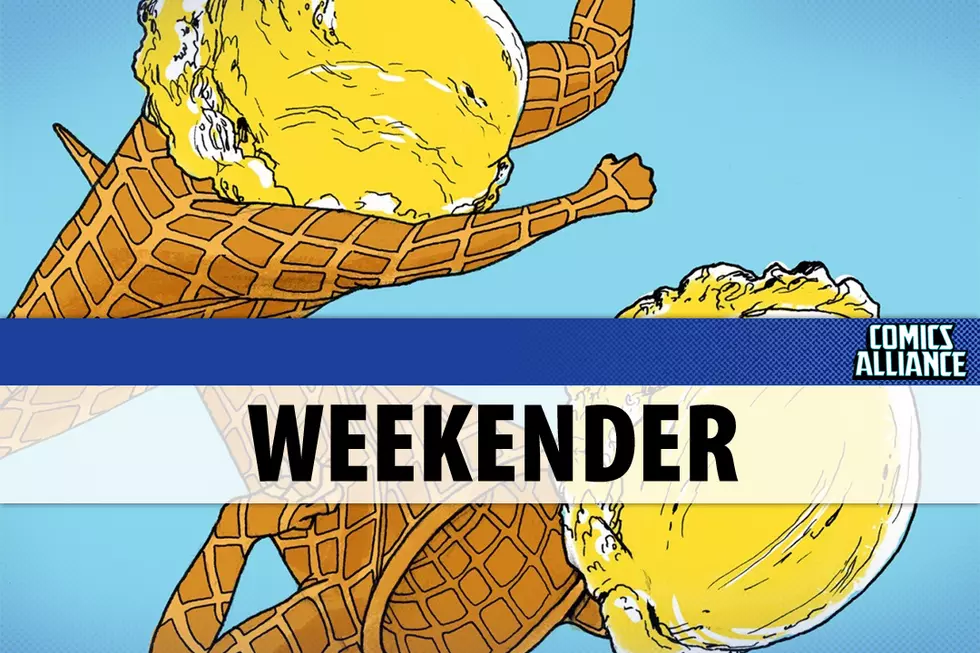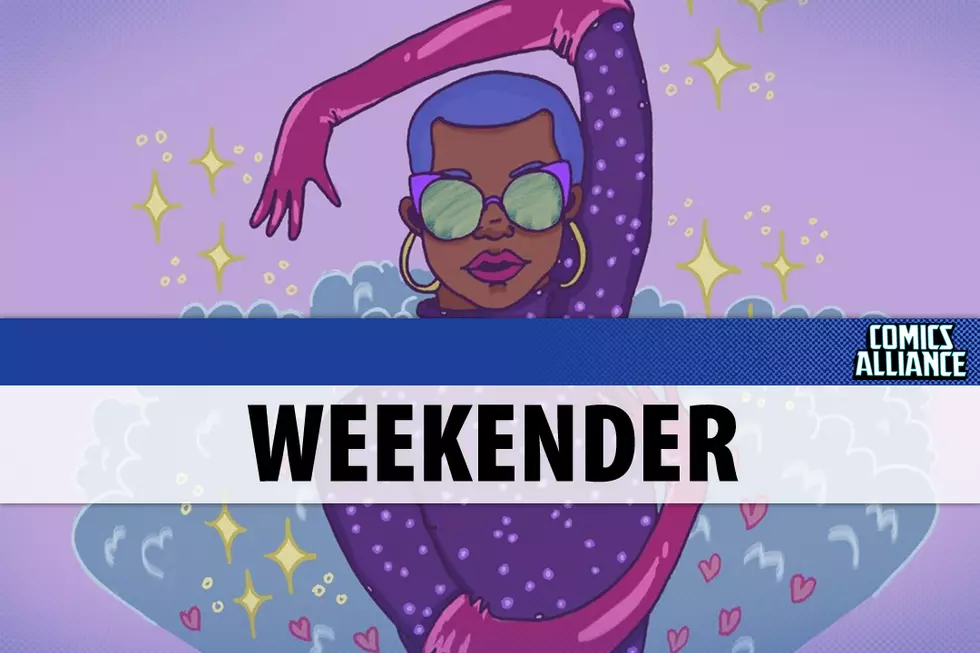
Drawn & Quarterly Celebrates 25 Years, Continues to Shape Comics for the Better
Lynda Barry has a story about Drawn & Quarterly saving her life. (She’s told the story many times, including in this 2012 Sunday Edition interview.) After her decades-long alt newspaper comic strip ended, after making her first foray into longform collage comics, and after being dumped by her publisher, she was holed up in her apartment. “There’s an old cartoonist up there,” the story goes. “We have to save her.”
Her knight in inkwash was Chris Oliveros, founder and until now, publisher of D&Q. Six years had passed since the release of One! Hundred! Demons! when D&Q released What It Is in 2008. She’s published a new work with D&Q every couple of years or so since, to critical acclaim.
D&Q recently celebrated its 25th anniversary at the Toronto Comic Arts Festival (TCAF). Making the occasion especially poignant was the last minute --- to the public, at least --- revelation that Oliveros was stepping down and leaving the company in the hands of longtime associate publisher Peggy Burns and her partner, former D&Q creative director, now executive editor, Tom Devlin. As Tom Spurgeon pointed out, Burns joins a short list of women leading major comics publishers.
The publisher has enjoyed a close relationship with the festival and its sponsoring comic shop, The Beguiling, thanks to a shared sense of mission. For the festival, that means “[promoting] the breadth and diversity of comics, and what is considered comics, as a legitimate medium of literary and artistic worth.”
TCAF marked the occasion with a whole host of D&Q panels and signings, even turning over the annual Friday night kickoff talk to the publisher. Barry was on hand to sing its praises, alongside fellow D&Q cartoonists Seth, Adrian Tomine, Jason Lutes, and Jillian Tamaki. She told her story --- “they saved me” --- and many cartoonists, up on that stage and scattered throughout the audience, nodded.
Founded in 1990 by 23-year-old bike courier Chris Oliveros, D&Q is Canada’s largest comics publisher and the one with the longest shadow. It ships over a dozen books internationally each year, mostly original graphic novels, but translations and artbooks too.
Adrian Tomine’s Optic Nerve --- a combination of short stories and serials --- has been going strong since 1995. North Americans can thank D&Q for our introduction to Tove Jannson’s Moomin books and Yoshihiro Tatsumi’s work; Canadians, our rediscovery of early Canadian cartoonists Laurence Hyde and Harry Mayerovitch.
To put it simply, the publisher is important. You may have been told this before --- believe it. It’s not just their back catalog, over two decades of beautiful books, that engenders such loyalty from cartoonists, retailers, and readers; it’s that sense of mission I mentioned above. It’s what festival director Chris Butcher described on that Friday night as an essential mix of activism, ideals, and aesthetics.
It is significant that D&Q’s first comic series was by Julie Doucet (Dirty Plotte), a French Canadian woman who made underground autobio comics about interpersonal relationships and menstruation. It is also significant that Chris Oliveros next took a gamble on Toronto cartoonist Seth’s pitch for Palookaville --- like Optic Nerve, it is an ongoing project --- without having seen a single page in the way of proposal or proof.
Oliveros gave both of them the production tools and determined backing necessary to make their comics everything they could be: beautiful and visible and “legitimate.” When asked about D&Q’s reputation for being a feminist publisher, Seth said there was nothing intentional in it; that the many beautiful books by female cartoonists were happenstance, a product of Oliveros’ impeccable taste.
After Doucet and Seth came Joe Matt (Peepshow), Maurice Vellekoop, Chester Brown (Paying For It), and a laundry list of now famous Canadian and American “alternative,” aka “literary,” cartoonists who didn’t quite fit into the oftentimes macho, certainly male-oriented, West Coast alternative comics scene -- many of them women. Is that happenstance? I don’t know Chris Oliveros personally, but I don’t think so.
There’s nothing accidental about his other accomplishments. Oliveros, himself a cartoonist, started D&Q with a monthly anthology comic in mind. He was inspired by Art Spiegelman and Françoise Mouly’s Raw, which serialized Spiegelman’s Maus, before it became the zero point for the graphic novel’s push into mainstream publishing.
Oliveros shares Mouly’s determination (present tense: Mouly continues to publish great comics and picture books at TOON Books) that comics are works of art, that they should be designed and packaged nicely, and that care for them should be evident. (These days, Maus is a required text in more than a few college level courses, and calling it overrated is still a hot take.)
When D&Q moved into comic serials, and later graphic novels, Oliveros carried those principles with him; their books are lovely, studies in the book as readable, touchable art object. When graphic novels started making headway in bookstores, he wrote and published a manifesto on how they should be displayed. He campaigned for a Dewey Decimal code just for comics, 741.5, so that comics could have a place of their own in libraries. And he developed, over the course of 25 years, a collaborative, creative space where cartoonists could enjoy stable, long term relationships with a publisher that respected their work to the utmost.
The recognition of new kinds of “art,” independent, alternative, and low, is political. The recognition of women’s work, of not just its equality but its excellence, is political. The mission of D&Q and other publishers like it is vital and necessary and political. It’s a statement: art, in all forms, from all people is valuable.
So much of this is history. The transformation in the public perception of comics, from “Superman, Garfield and, hey, also Far Side,” to a medium where anything is possible took place during my childhood and teen years; before some of you were even born. What is the significance of ISBNs and Dewey Decimals for comics? Of a Canadian publisher that ships alternative Toronto comics to Tokyo, and from Tokyo to Seattle? That’s kind of normal, now. We’re over it.
But imagine the novelty for that first wave of self-published cartoonists seeing their work and that of their friends in bookstores for the first time. Jillian Tamaki, whose Indoor Voice was published by D&Q in 2010, said that it was weird for her to think about: the time before comics had a place in the literary canon; a place recognized as legitimate. Of the publisher she said, “I don't think the layperson understands what it's like to work with D&Q versus a publisher that buys project by project.” And Jason Lutes, who’s been publishing Berlin with D&Q since 1996, said that after art school and interning at Fantagraphics, he was disillusioned with the alternative comics scene. It was “too cynical.” (His words, Fanta diehards, not mine.) D&Q, and Oliveros, were something different: supportive, collaborative, curious, and diverse.
This year, Drawn & Quarterly turns 25 and as Chris Oliveros steps down to focus on his own cartooning, Peggy Burns steps up. This too, is history. More women heading comics publishing companies, more LGBTQ people, and more people of colour --- imagine when this becomes normal; when future cartoonists look back and thank us for this space we can make.
But let me close with another Lynda Barryism, that so completely captures the conceptual distance traveled over 25 years: “I think everybody can make comics. Everybody does make comics. We think in comics ... little scenes.”
Thank you, D&Q, for bringing me Lynda Barry, and for other cartoonists who push the limits of what comics can and should be.
More From ComicsAlliance









